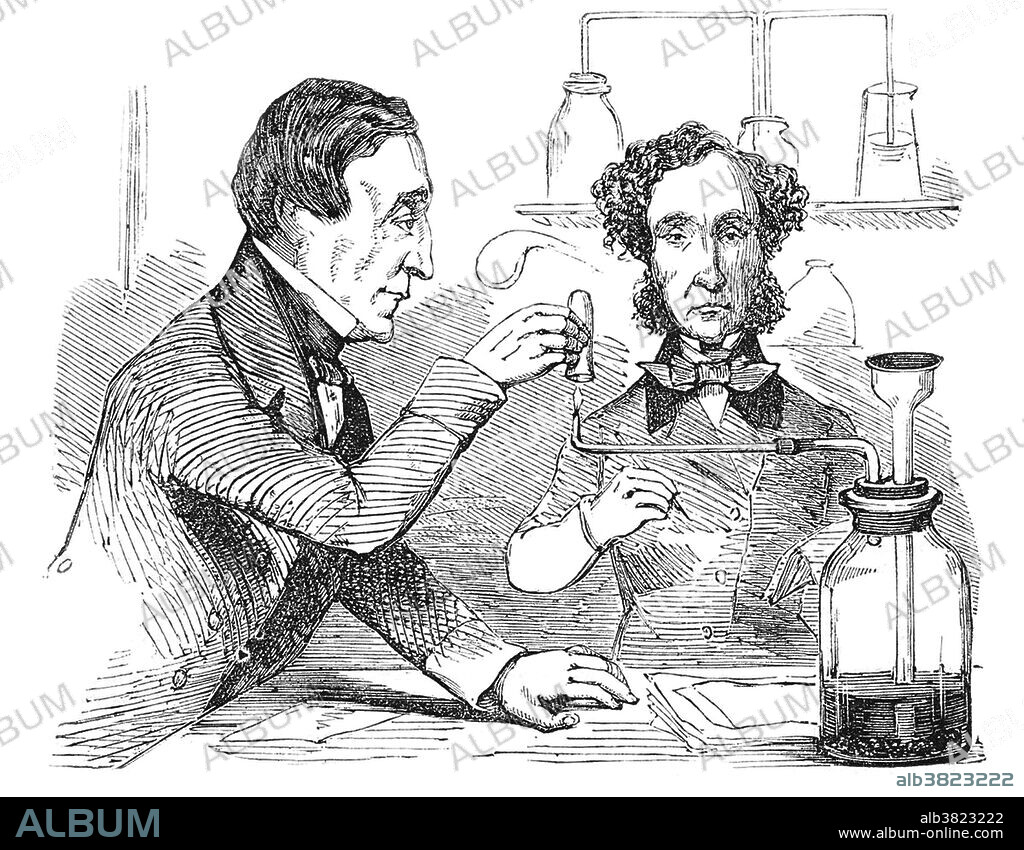alb3823222
Performing the Marsh Test, 1856

|
Add to another lightbox |
|
Add to another lightbox |



Buy this image.
Select the use:

Title:
Performing the Marsh Test, 1856
Caption:
Performing the Marsh Test, 1856. Doctor Alfred Swaine Taylor (left) and a colleague, performing the Marsh test on samples taken from the body of John Parsons Cook. The two were looking for traces of arsenic and antimony. The Marsh test is a method for the detection of minute amounts of arsenic in foods (the residue of fruit spray) or in stomach contents. The sample is placed in a flask with arsenic-free zinc and sulfuric acid. Arsine gas (also hydrogen) forms and is led through a drying tube to a hard glass tube in which it is heated. The arsenic is deposited as a "mirror" just beyond the heated area and on any cold surface held in the burning gas emanating from the jet. Antimony gives a similar test, but the deposit is insoluble in sodium hypochlorite, whereas arsenic will dissolve. The test was named for its inventor, the English chemist James Marsh.
Category:
Science: Personalities
Credit:
Album / NLM/Science Source
Releases:
Image size:
3600 x 2802 px | 28.9 MB
Print size:
30.5 x 23.7 cm | 12.0 x 9.3 in (300 dpi)
Keywords:
1856 • 19TH CENTURY • ALFRED SWAINE TAYLOR • ALFRED TAYLOR • ANALYSIS • ANTIMONY • ARSENIC • ARSENIC-FREE ZINC • ARSINE GAS • ART • ARTWORK • BURNING GAS • BW • CELEBRITIES • CELEBRITY • CHEMIST • COLD SURFACE • CRIME • CRIMINAL INVESTIGATION • DEPOSITED • DETECTION • DRAWING • DRYING TUBE • ENGLISH • FAMOUS PEOPLE • FAMOUS • FIGURE • FLASK • FORENSIC • HARD GLASS TUBE • HEATED • HISTORIC • HISTORICAL • HISTORY • HYDROGEN • ILLUSTRATION • ILLUSTRATIONS • ILUSTRATION • IMPORTAN • INSOLUBLE • INTOXICATION • INVENTION • JAMES MARSH • JOHN PARSONS COOK • LEGAL • MALE • MAN • MARSH TEST • MEDICAL EXAMINER • MEDICAL • MEDICINAL • MEDICINE • MEN • METHOD • PEOPLE • PERFORMING TEST • PERSON • PERSONALITIES • PERSONALITY • POISON • POISONING • RESEARCH • SAMPLE • SCIENCE • SCIENCE: PERSONALITIES • SODIUM HYPOCHLORITE • SULFURIC ACID • TAYLOR • TECHNIQUE • TESTING • TOXICOLOGIST • TOXICOLOGY • TRACE AMOUNT • WELL-KNOWN


 Pinterest
Pinterest Twitter
Twitter Facebook
Facebook Copy link
Copy link Email
Email
